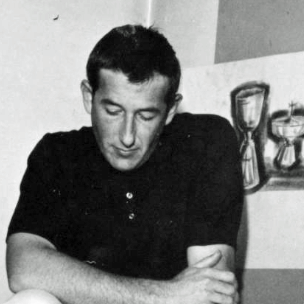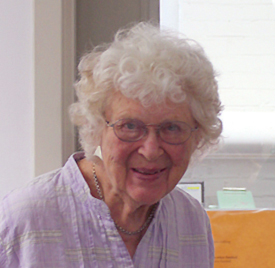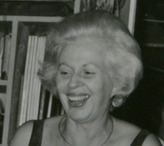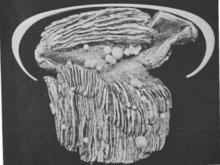Stanley Lechtzin is an American artist, jeweler, metalsmith and educator. He is noted for his work in electroforming and computer aided design (CAD) and computer aided manufacture (CAM). He has taught at Temple University in the Tyler School of Art and Architecture, from 1962.
John Rais is an American designer, blacksmith and sculptor, known for his decorative architectural work, vessels, and furniture. Rais primarily works in steel as well as titanium, bronze, copper, stainless steel, and other materials. He is well known for his one-of-a-kind firescreens. He has resided in Layton, New Jersey; and Philadelphia, Pennsylvania.
Ellen M. Wieske is an American artist, metalsmith, goldsmith, curator, educator, author, and an arts administrator. She is the deputy director of the Haystack Mountain School of Crafts. Wieske is known for her wirework pieces.

Mary Lee Hu is an American artist, goldsmith, and college level educator known for using textile techniques to create intricate woven wire jewelry.

L. Brent Kington was an art educator and visual artist who worked in blacksmithing and sculpture. Kington was a product of the studio craft movement in jewelry and hollowware. In 1969 he served as the first president of the Society of North American Goldsmiths. He is frequently hailed as the man responsible for the blacksmithing revival which took place in the late 1960s and early 1970s.

Fred Fenster is a metalsmith and professor emeritus of the University of Wisconsin at Madison where he taught art and education. He is particularly known for his work in pewter, influencing generations of metalsmiths. Fenster was named a Fellow of the American Craft Council in 1995.
Gary Lee Noffke is an American artist and metalsmith. Known for versatility and originality, he is a blacksmith, coppersmith, silversmith, goldsmith, and toolmaker. He has produced gold and silver hollowware, cutlery, jewelry, and forged steelware. Noffke is noted for his technical versatility, his pioneering research into hot forging, the introduction of new alloys, and his ability to both build on and challenge traditional techniques. He has been called the metalsmith's metalsmith, a pacesetter, and a maverick. He is also an educator who has mentored an entire generation of metalsmiths. He has received numerous awards and honors. He has exhibited internationally, and his work is represented in collections around the world.

June Schwarcz was an American enamel artist who created tactile, expressive objects by applying technical mastery of her medium to vessel forms and plaques, which she considers non-functional sculpture.

Lois Etherington Betteridge was a Canadian silversmith, goldsmith, designer and educator, and a major figure in the Canadian studio craft movement. Betteridge entered Canadian silversmithing in the 1950s, at a time when the field was dominated by male artists and designers, many of them emigrés from the United States, the United Kingdom, and Europe. In fact, Betteridge was the first Canadian silversmith to attain international stature in the post-war studio craft movement.
Susie Ganch is a first generation American artist of Hungarian heritage. She is a sculptor, jeweler, educator, and founder and director of Radical Jewelry Makeover. Ganch received her Bachelors in Science from the University of Wisconsin-Madison in Geology in 1994 and her Masters in Fine Arts from the University of Wisconsin-Madison in 1997.
Lola Brooks is an educator specializing in jewelry. Brooks' works have been shown at places such as the National Ornamental Metal Museum, The Society of Arts and Crafts, Cleveland Museum of Natural History, the Museum of Craft and Folk Art, and Talente and are held in the permanent collection of The Museum of Art and Design, the Metropolitan Museum of Art.
Jamie Bennett is an American artist and educator known for his enamel jewelry. Over his forty-year career, Bennett has experimented with the centuries-old process of enameling, discovered new techniques of setting, and created new colors of enamel and a matte surfaces. This has led him to be referred to as “one of the most innovative and accomplished enamellers of our time” by Ursula Ilse-Neuman, historian and former curator at the Museum of Art and Design in New York City. Bennett is closely associated with the State University of New York at New Paltz, where he studied himself as a student, and taught in the Metal department for many years. Bennett retired from teaching in 2014, after thirty years at SUNY New Paltz.
Myra Mimlitsch-Gray is an American metalsmith, artist, critic, and educator living and working in Stone Ridge, New York. Mimlitsch-Gray's work has been shown nationally at such venues as the John Michael Kohler Arts Center, Museum of the City of New York, Metropolitan Museum of Art, Cooper-Hewitt Smithsonian Design Museum, and Museum of Arts and Design. Her work has shown internationally at such venues as the Middlesbrough Institute of Modern Art, Stadtisches Museum Gottingen, and the Victoria and Albert Museum, and is held in public and private collections in the U.S, Europe, and Asia.

Alma Rosalie Eikerman was an American metalsmith, silversmith, and jewelry designer who was instrumental in building the metals program at Indiana University, of which she retired Distinguished Professor Emeritus. She was a founding member of the Society of North American Goldsmiths and studied under several internationally renowned metalsmiths, such as Karl Gustav Hansen. Eikerman's work has appeared in over 200 exhibitions, including Objects: USA at the Smithsonian Institution.
Linda Threadgill is an American artist whose primary emphasis is metalsmithing. Her metal work is inspired by forms of nature and the interpretations she gleans from the intricate patterns it presents. She explores the foundation of nature to allude to nature and transform it into re-imagined, stylized plants forms.
Vivian Beer is an American designer of metal furniture.

Dorothy Gill Barnes was an American artist. She was known for her use of natural materials in woven and sculpted forms.
Hiroko Sato-Pijanowski is a Japanese jewelry designer, artist, author and educator. Sato-Pijanowski is credited with introducing Japanese materials and techniques to American metal working. She is based in Yokohama in Kantō, Japan.

Mary Ann Scherr was an American designer, metalsmith and educator. She was known for her jewellery design and industrial design, but she also worked as a graphic designer, illustrator, game designer, fashion and costume designer and silversmith.
Marilyn da Silva is an American sculptor, metalsmith, jeweler, and educator. She teaches and serves as a department head at the California College of the Arts in the San Francisco Bay Area. Da Silva has won numerous awards including honorary fellow by the American Craft Council (2007).








